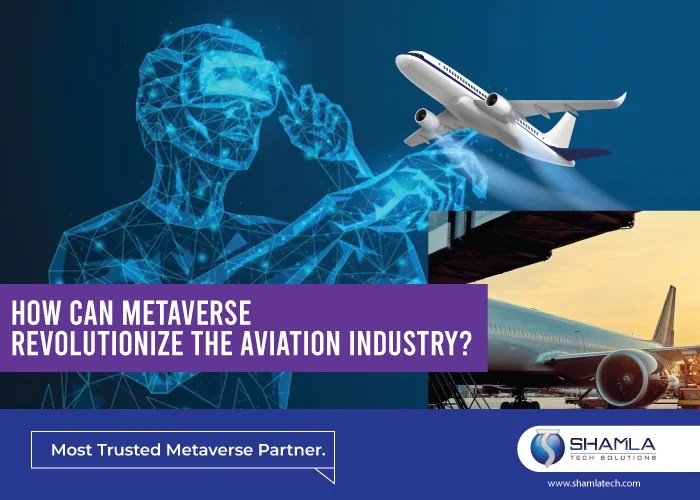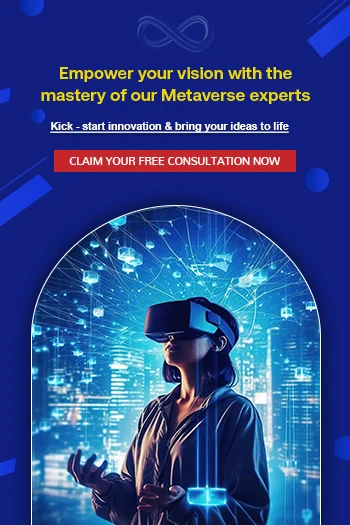Metaverse is gaining a lot of popularity in recent times across different industries and the Aviation industry is no exception. Metaverse Aviation is the integration of virtual and physical aviation environments, creating a seamless experience for travelers that incorporates both digital and real-world elements. The term “Metaverse” refers to a virtual world where people can engage in various activities, just like in the real world. Several high-profile companies are actively investing in the development of Metaverse platforms. Metaverse Aviation is picking up the pace for its potential to offer various opportunities.
What Is Aviation In The Metaverse?
Aviation in the Metaverse refers to the virtual representation and simulation of aviation-related activities within a digital world. The Metaverse is a virtual space where users can interact with each other and also with digital objects, often using virtual reality (VR) or augmented reality (AR) technology. In the Metaverse, aviation can take many forms. For example, users can fly virtual airplanes or drones, participate in virtual air shows, or experience simulations of real-world aviation scenarios.
Additionally, aviation-related industries, such as aerospace engineering and air traffic control, could potentially use the Metaverse as a platform for training and research. Metaverse also offers exciting opportunities for exploring and experiencing aviation in new and innovative ways. As technology continues to advance, it will be interesting to see how aviation in the Metaverse evolves and what new applications are developed.
Benefits Of Metaverse In The Aviation Industry
The term “Metaverse Aviation” could refer to the application of virtual or augmented reality technologies in the aviation industry. This could include the use of immersive simulations and training programs for pilots and air traffic controllers. It also offers virtual reality experiences for passengers, such as in-flight entertainment or the ability to explore different destinations before traveling. This could involve the use of advanced technologies such as drones, autonomous vehicles, and smart airports, which are designed to enhance the efficiency and safety of air travel.
As the concept of the Metaverse continues to evolve and become more integrated into our daily lives. It’s likely that we will see new applications and innovations in the aviation industry that leverage these technologies to improve the travel experience for everyone involved. The aviation industry can utilize the potential of the Metaverse in several ways, including:
1. Design And Prototyping
Aircraft manufacturers can use Metaverse technology to create 3D models of their aircraft and simulate various scenarios to test the design and functionality of their planes. This can help identify potential issues early on in the design process, leading to more efficient and cost-effective production. It allows engineers and designers from around the world to work together in a virtual environment, enabling real-time collaboration and communication. This can speed up the design process and reduce the need for travel, ultimately saving time and money. It also helps simulate various aircraft manufacturing scenarios, providing an immersive and interactive learning experience for employees. Additionally, this can help improve their skills and increase their knowledge, leading to a more efficient manufacturing process.
2. Virtual Training
One potential application of aviation in the Metaverse is the use of virtual reality to train pilots. VR simulations can provide a safe and cost-effective way for pilots to practice emergency procedures and other critical skills. Similarly, the Metaverse could be used to simulate air traffic control scenarios, allowing controllers to practice managing air traffic without putting real-life flights at risk. This could also enable pilots to familiarize themselves with new aircraft models and airports, increasing safety and efficiency.
3. Virtual Conferences
Metaverse Aviation facilitates conducting virtual meetings between pilots, crew members, and ground staff, saving time and reducing the need for physical travel. The aviation industry can use the Metaverse to host virtual conferences and trade shows, allowing professionals to network and share knowledge without having to travel. This can reduce the carbon footprint associated with air travel, and also make events more accessible to people who might not be able to attend in person.
4. Passenger Experience
The Metaverse can be used to enhance the passenger experience, allowing them to preview their flights, choose seats, and explore the airport, their aircraft, and their destination in a virtual environment. This can provide a more immersive and interactive experience for travelers, and also help airlines to promote their brands and services. In addition, Metaverse Aviation could help airlines differentiate themselves and improve customer satisfaction.
5. Marketing And Advertising
The Metaverse can be used as a new platform for marketing and advertising, allowing airlines to reach a global audience in an innovative and engaging way. This can include creating virtual experiences or events or even partnering with other companies within the Metaverse to reach new audiences. The Metaverse could provide new opportunities for airlines to generate revenue, such as through virtual advertising and sponsorships, and the sale of virtual products and services.
6. Maintenance And Repairs
The Metaverse helps to provide maintenance and repair services for aircraft, allowing engineers to access virtual models and simulations to diagnose and fix issues. This can reduce the need for physical inspections and repairs, and also provide a more efficient and cost-effective solution. In addition, Metaverse aviation helps to monitor and optimize airport and airline operations, allowing for real-time tracking of flights, luggage, and personnel. This could improve efficiency and reduce delays, enhancing the overall customer experience.
Metaverse offers a wide range of opportunities for the aviation industry to innovate and improve its operations, services, and also customer experiences. By embracing this technology, airlines can stay ahead of the curve and provide a competitive edge in an increasingly digital world.
Features Of Metaverse Airport
An airport Metaverse could be a virtual world that simulates an airport environment. Metaverse airport is a virtual location within a Metaverse that serves as a hub for transportation to other virtual destinations. It could have various features such as virtual check-in counters, departure and arrival gates, and virtual shops and restaurants.
In this Metaverse, users can also navigate through a digital representation of an airport, interact with other users, through avatars, chat rooms, & forums, and participate in various activities. It could also be used for entertainment, such as allowing users to experience the excitement of air travel from the comfort of their own homes. Some possible features of an airport Metaverse could include:
Terminal Building
A digital version of the airport terminal building, complete with shops, restaurants, and lounges.
Boarding Gates
Virtual gates where users can board their flights and can also watch planes take off and land.
Security Checkpoints
Simulated security checkpoints where users can experience the airport security process.
Airline Check-in Counters
Virtual check-in counters for airlines where users can check in for their flights and also print boarding passes.
Air Traffic Control Tower
A digital version of the airport’s air traffic control tower, where users can see the flight traffic and communicate with the tower.
Aircraft Hangars
A virtual space for users to explore and learn about aircraft.
Aviation Education Center
A space for users to learn about aviation history, different aircraft types, and airport operations.
Similar to an airport in the physical world, a Metaverse airport could be a central point where users arrive and depart to different virtual locations within the Metaverse. As the concept of a Metaverse is still evolving, the specifics of what a Metaverse airport might look like and how it would function are yet to be fully developed. However, as the idea of a Metaverse continues to gain traction, it’s possible that we will see virtual transportation hubs like Metaverse airports emerge as a central part of the overall virtual experience.
AR And VR In Aviation

Augmented Reality (AR) and Virtual Reality (VR) have been increasingly used in aviation in recent years. It is being significantly employed in various aspects of aviation. AR and VR are used in flight simulators to provide pilots with a more realistic training experience. It can also help pilots improve their situational awareness by overlaying critical flight information in the real world. This can be especially helpful for training in emergency procedures, weather conditions, and different types of aircraft.
These technologies help to assist maintenance personnel in diagnosing and fixing problems on aircraft. By using VR glasses, technicians can see a digital overlay of the aircraft’s systems, highlighting any issues or anomalies. It can enhance the passenger experience by providing them with additional information about the flight, such as real-time information about the aircraft’s speed, altitude, and location. It can also help passengers navigate through airports by overlaying directions and information onto their mobile devices.
AR and VR can offer remote assistance to pilots and maintenance personnel. By using AR glasses or mobile devices, experts can provide real-time guidance and support, reducing downtime and improving operational efficiency. VR and AR in aviation can also help air traffic controllers in complex airspace scenarios, helping to improve their decision-making skills and ability to manage multiple aircraft. The use of AR and VR in aviation has a lot of potential in aviation to improve safety, efficiency, training, simulation, and the passenger experience. As technology continues to evolve, we can expect to see even more applications of VR and AR in aviation in the future.
How Shamla Tech Helps You With Metaverse Aviation Services?
Shamla Tech is a renowned Metaverse Development Company that helps to create your own Metaverse for Aviation Industry. We help you with the creation of a virtual world of Metaverse Aviation, including the airports, aircraft, air traffic control systems, and other aviation-related elements. In the context of the aviation industry, we help you create a virtual world to access and experience the aviation-related activities and services. As a leading Metaverse development company, we could create the underlying infrastructure for Metaverse Aviation, such as the servers, databases, and networking technologies needed to support the platform.
We could work with existing aviation systems and technologies to ensure that Metaverse Aviation is integrated with the real-world aviation industry. This would involve developing interfaces and protocols that allows to share the data between the virtual world and the real world. We leverage the latest virtual reality and augmented reality technologies to create immersive experiences for users of Metaverse Aviation. In addition, our experts can create realistic simulations that allow users to practice real-world scenarios and improve their skills and knowledge. Metaverse could revolutionize the aviation industry by providing new opportunities for efficiency, safety, and revenue generation.



